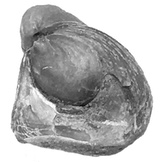Sequence Stratigraphy of the Type Cincinnatian Series: Meter-Scale Cycles
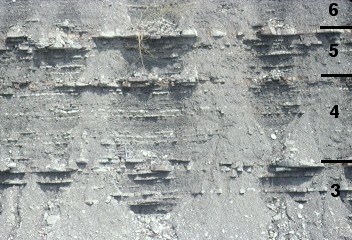
Within the type Cincinnatian Series, meter-scale lithologic cyclicity is well-developed in offshore facies, such as the Kope and Waynesville Formations. It is also similarly but less-well developed in deep subtidal facies such as the Fairview, Corryville, Sunset, and Liberty Formations. Meter-scale cyclicity is curiously absent within shallow subtidal facies, such as the Bellevue, Mount Auburn, Oregonia, and Whitewater Formations, and within peritidal facies, such as the Saluda Formation.
In the offshore and deep subtidal units, meter-scale cyclicity is expressed as alternation between shale-rich and limestone-rich intervals. These cycles vary in their thickness, but are usually between half a meter and 3 meters thick. Several meter-scale cycles are shown to the left from an exposure of the Kope Formation at the base of the K445 section in northern Kentucky.
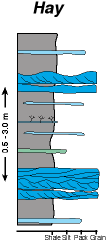
Helen Hay, working on her Ph.D. dissertation at Miami University, was among the first to describe this cyclicity. She characterized these cycles simply as alternations of shale-rich and limestone-rich strata, typically on the meter-scale. In particular, Hay focussed on the relatively even spacing of thick grainstone beds that formed the cycle boundaries. Hay also suggested that this clustering of storm beds could reflect cyclicity in the occurrence of severe storms over time.
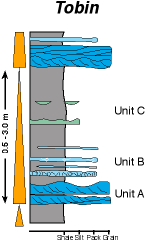
Rick Tobin, working on his Ph.D. dissertation at the University of Cincinnati at the same time as Hay, also recognized the meter-scale cycles, but went into more detail about their internal structure. Initially, Tobin and his advisor, Wayne Pryor, characterized the cycles as consisting of a basal unit of intraclastic and bioclastic grainstones, a middle unit with bioclastic packstones and shales, and an upper unit with shales and rippled calcisiltites. They emphasized the overall fining-upward structure of the cycles as well as the sharp contacts of the basal grainstone unit on the upper shale unit of the underlying cycle. They also noted variation in cycle structure, with the middle unit commonly absent. Shortly thereafter, Tobin reappraised the meter-scale cycle structure. Because the middle unit of Tobin and Pryor was absent in most of the cycles, Tobin recharacterized the cycles as consisting of a lower carbonate hemicycle and an upper shale hemicycle. The carbonate hemicycle was dominated by thick and closely spaced bioclastic grainstones, packstones, wackestones, and calcisiltites and contained less than 20% shale. The shale hemicycle was described as containing greater than 70% shale, but included thin siltstones, calcisiltites, and lime mudstones.
Tobin's thoughts on the origin of the meter-scale cycles also changed over time. Tobin and Pryor originally favored an autocyclic model involving the formation and abandonment of local highs on the seafloor. They envisioned lobes of shale deposited during storms, with intervening blankets of bioclastic sand. The location of these mud lobes would shift through time, and as a result, the cycles should not correlate from one locality to another. Later, Tobin recognized that these cycles could be correlated for tens of kilometers and advanced a new explanation, in which he argued that the cycles formed by eustatic changes in sea level. In this way, the limestones were deposited during relative lowstands and the muds during relative highstands. Because Tobin thought that the transition from the limestone hemicycle to the shale hemicycle was gradual, but that the opposite transition was abrupt, he argued that the meter-scale cycles represented deepening-upward eustatic cycles.
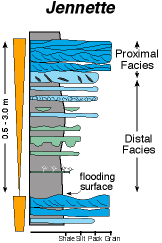
David Jennette focussed on the sedimentology of these meter-scale cycles for his master's thesis at the University of Cincinnati, directed by Wayne Pryor several years after Tobin's dissertation. Jennette's work remains the most thorough sedimentologic characterization of these cycles. Jennette applied Tom Aigner's concept of storm bed proximality to the meter-scale cycles in the Kope and Fairview Formations.
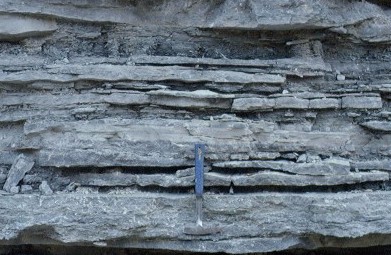
The idea of proximality is that storm beds can be ranked along a proximal-distal gradient, with proximal storm beds characterized by coarse grain size, large-scale crossbedding and megaripples, intraclasts, and amalgamation surfaces (erosional surfaces in which one storm sand layer rests directly on another, with no intervening shale).
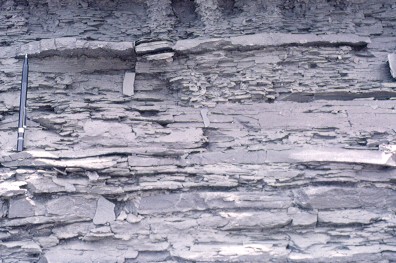
Distal storm beds are characterized by thin basal skeletal lags and planar-laminated, wave-rippled laminated, and hummocky cross-laminated silts. Even more distal storms beds are characterized by slightly silty graded mudstone beds. Whether a proximal or distal storm bed develops at any given location is controlled by water depth (shallow favors proximal), storm location (nearby favors proximal), and storm intensity (stronger storms favor proximal).
Jennette recognized a distinction in meter-scale cycles between intervals dominated by distal storm beds (his distal facies) and those dominated by proximal storm beds (his proximal facies). He also recognized, contrary to Tobin's observations, that the transition from proximal to distal facies is abrupt, whereas the transition from distal to proximal tends to be gradational. As a result, Jennette described the meter-scale cycles as shallowing-upward cycles bounded by flooding surfaces (surfaces across which deep-water facies rest abruptly on shallow-water facies), cycles that are known as parasequences (see Online Guide to Sequence Stratigraphy). Jennette attributed these changes in water depth to glacially-driven eustatic sea-level fluctuations.
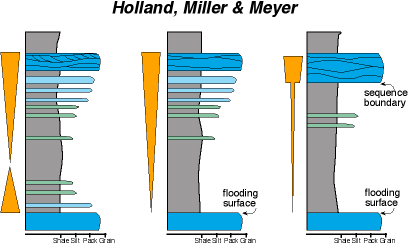
More recently, Steven Holland, Arnie Miller, Ben Dattilo, and David Meyer have examined the stratigraphy and paleontology of the Kope Formation and its meter-scale cycles. They recognized a much broader diversity in cycle patterns than either Tobin or Jennette described. Some cycles shallow upwards smoothly, some abruptly, and some have deepening-upward intervals, all indicated by storm proximality trends. Holland and coauthors suggested that these cycles may have been produced by eustatic fluctuations or that the changes in proximality may reflect changes in storm intensity rather than water depth. More recently, they have discussed why it is unlikely that these meter-scale cycles reflect any significant change in water depth. First, Andrew Webber has shown that the meter-scale cycles do not display consistent changes in fossil composition that would be expected if they reflected water depth. Second, meter-scale cyclicity is absent in shallow subtidal and peritidal facies - precisely those facies that should be most prone to preserving water depth cycles. Third, meter-scale cycles do not change in their structure in a way that would be predicted if they were produced by water depth changes, that is, they do not mimic the larger-scale cycles known to be driven by changes in water depth.
